What Are the Best Quilting Styles for a T-shirt Quilt?
Updated: July 15th, 2024 | Published: March 26th, 2024
5 min. read
By Andrea Funk
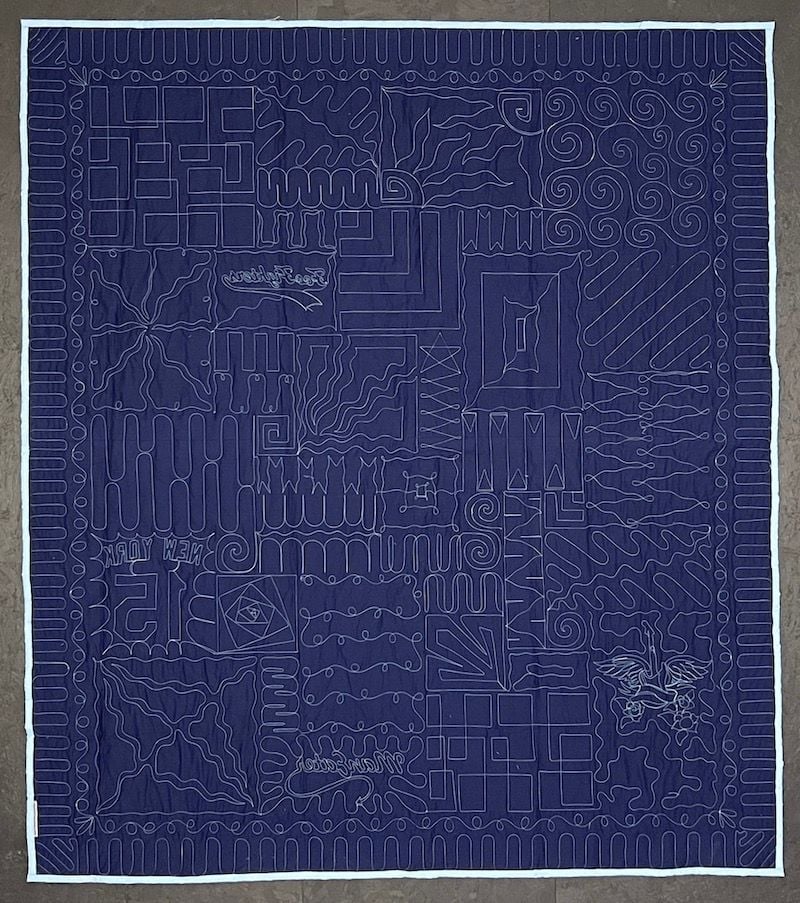
4 Typical Quilting Methods for T-shirt Quilts.
1. Tying
2. Stitch-in-the-Ditch
3. Computer Driven Long-Arm Quilting
4. Non-Computer Driven Long-Arm Quilting
• Operated from the Back of the Machine
• Operated from the Front of the Machine
 Are you getting ready to have a quilt made from your T-shirts? If so, there are a lot of choices you need to make about your quilt. One of the big question is what quilting style? It's an important decision. It will influence the look and life of your quilt.
Are you getting ready to have a quilt made from your T-shirts? If so, there are a lot of choices you need to make about your quilt. One of the big question is what quilting style? It's an important decision. It will influence the look and life of your quilt.
First, we will explore the different quilting options available for a T-shirt quilt.
Next we will show you how to identify the different styles in photos on the web. Armed with this information, you will be able to figure out what you like and don’t like.
Definition: Quilting Is What Holds the Front, Batting and Backing of a Quilt Together
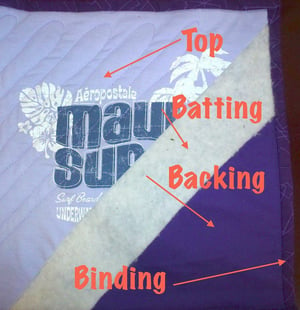 A quilt has three layers – the quilt top, the batting and the backing material. These three layers must be connected together to make the quilt.
A quilt has three layers – the quilt top, the batting and the backing material. These three layers must be connected together to make the quilt.
If the layers aren't connected or are connected sparsely, the batting can bunch up and be lumpy. In the quilting world, the lingo used to describe the connecting of these three layers is called “quilting.”
If a quilt doesn't have quilting it is not a quilt. It would be a blanket. Here's more about the differences between a quilt and a blanket.
4 Typical Quilting Methods Used on T-shirt Quilts
1. Tying
Horse%20logo%20close%20up%20with%20manetail%20ties.jpg?width=400&name=c)Horse%20logo%20close%20up%20with%20manetail%20ties.jpg) Tying is a technique that uses thread or embroidery floss or yarn to make a single large stitch through the three layers of the quilt. The thread is knotted on the top of the quilt.
Tying is a technique that uses thread or embroidery floss or yarn to make a single large stitch through the three layers of the quilt. The thread is knotted on the top of the quilt.
Ties should be placed every 4 inches to secure the three layers. If the ties are too far apart, the batting may sag and bunch over successive washings.
Although this method holds a quilt top, batting, and backing together, it may not stand the test of time. Ties can come untied. The T-shirt material might rip between ties.
Tying is a great choice if you are looking for a low-cost quilt.
2. Stitch-in-the-Ditch
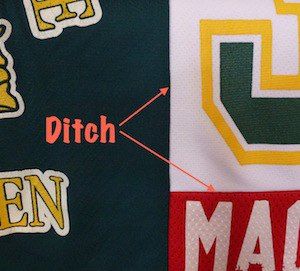 This method is done using a home sewing machine. The three layers of the quilt are pinned and then stitched together. The stitches are placed in the ditch. On a quilt, the ditch is where the seams of the blocks come together.
This method is done using a home sewing machine. The three layers of the quilt are pinned and then stitched together. The stitches are placed in the ditch. On a quilt, the ditch is where the seams of the blocks come together.
Stitching in the ditch will hold the quilt together. You might have problems in the areas that are not sewn down. That is the middle of a block. These areas will droop and sag over time. This is because the quilting is not close enough. Most batting manufacturers say, “for the best outcome, stitching will need to be no more than 4 inches apart.” Stitch-in-the-ditch quilting leaves large areas un-quilted.
Like the tying method, this is not a long-lasting solution. After several washings, the batting in the unstitched areas can ball-up inside the quilt. This makes for a lumpy quilt.
3. Computer Driven Long-Arm Quilting
Definition: A long-arm quilting machine is a sewing machine that rides rails along an X/Y axes.
The machine moves over the three layers of a quilt.
A computer or a human can control or drive a long-arm quilting machine.
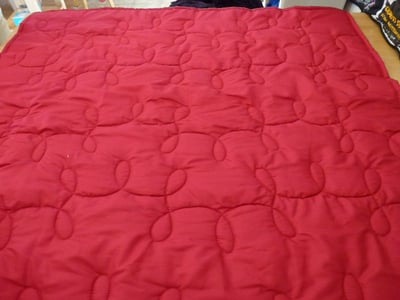 When the quilting is computerized, the T-shirt quilt is typically stitched with an overall quilting pattern. The same design repeats over and over on the quilt.
When the quilting is computerized, the T-shirt quilt is typically stitched with an overall quilting pattern. The same design repeats over and over on the quilt.
This quilting method does result in a quilt that will last for a lifetime. If... quality materials have been used for the backing, thread and correct number of stitches per inch.
If you choose a company using computerized long-arm quilting, be sure you like the pattern you choose. That pattern is going to be repeated over and over throughout the entire quilt.
4. Non-Computer Driven Long-Arm Quilting
This method uses the same long-arm quilting machine but a human operates it from either the front or back of the machine.
Operated from the Back of the Machine
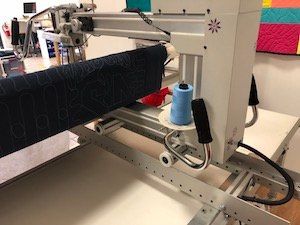 Here, the long-arm machine operator stands or sits behind the long arm machine.
Here, the long-arm machine operator stands or sits behind the long arm machine.
The quilter follows a printed-paper pattern on the bed of the sewing machine with a laser pointer. As in computerized machine quilting, the designs are repetitive.
Operated from the Front of the Machine
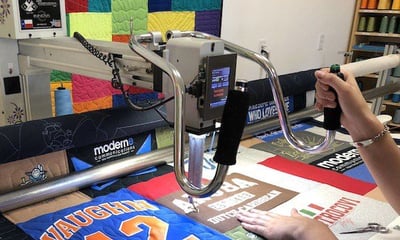 The long-arm machine operator works from the front of the machine - this is the quilt side. The designs are exclusively tailored to the particular block being quilted. The result can be a quilting design that is exciting and different on each block of the quilt.
The long-arm machine operator works from the front of the machine - this is the quilt side. The designs are exclusively tailored to the particular block being quilted. The result can be a quilting design that is exciting and different on each block of the quilt.
Bonus – the back of the quilt is as fun as the front. The long-arm quilting artist can choose to outline or trace the designs on the T-shirts or freehand designs as they work.
 Why is this the best style for T-shirt quilts?
Why is this the best style for T-shirt quilts?
- The quilter can tailor the design to the graphic on the T-shirt block.
- The quilter can watch for and eliminate batting lumps and wrinkles as they work.
- The quilting is dynamic and interesting.
- The back of the quilt is fun.
The drawback to this is that it will cost more than any other style of quilting. This is because is it time consuming and requires an artist.
This is the quilting style that we use here at Too Cool T-shirt Quilts.
Planning a T-shirt quilt?
Here are step-by-step directions for ordering your Too Cool T-shirt quilt.
How to Identify a Quilting Style You Would Like From Photographs
 Figuring out what you like will take a little sleuthing.
Figuring out what you like will take a little sleuthing.
If you just Google “the back of a T-shirt quilt” you won’t see much. There are not a lot of photos of the backs of T-shirt quilts. Why? Photos of the back of a T-shirt quilt are difficult to take well.
You will need to click into a quilt maker's website to find photographs of the backs of their quilts.
No Quilting
This is a blanket – read more about blankets here. A blanket will have a flat backing with no indentations. A blanket and a quilt are different. If you want a quilt, make sure it has some type of quilting.
In the photo here, on the left is the back of a blanket. You can see there is no quilting. On the right is a back of a Too Cool T-shirt Quilt. You can see the quilting.

Tied Quilts
-
This method will give a quilt a slight polka-dotted pattern.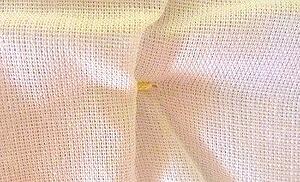
- There will be a divot in the quilt where each tie is located
- The quilt here was machine tacked (the same as tying) at each intersection where blocks come together.
Stitch-in-the-ditch Quilts
- Look for a depression along each seam.
- The back of the quilt will be quilted in squares that correspond to the outline of the blocks.
- The T-shirt blocks will be smooth and not show any quilting.
Over-all Quilted
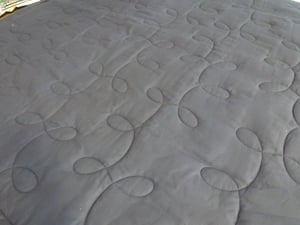 A printed backing material may be used. Read more about using a print on the back of a T-shirt quilt here. A print material hides quilting. You can’t see the quilting because the printed material overwhelms the quilting.
A printed backing material may be used. Read more about using a print on the back of a T-shirt quilt here. A print material hides quilting. You can’t see the quilting because the printed material overwhelms the quilting.- If you look at the front of the quilt you will see that the stitching goes over the seams.
- Follow the stitching with your eyes and look for a repeat in the pattern.
In the photo below, the quilt on the right is quilted in an overall loop pattern. On the right is a back of a Too Cool T-shirt Quilt. You can see the quilting. There is more quilting in one block of a Too Cool T-shirt Quilt than here is in the entire quilt on the left!
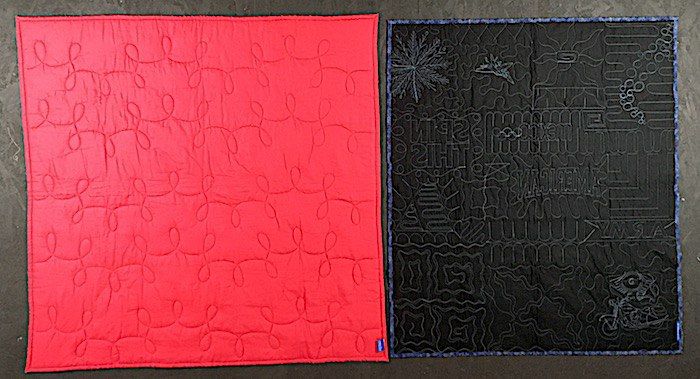
Individually Quilted Blocks
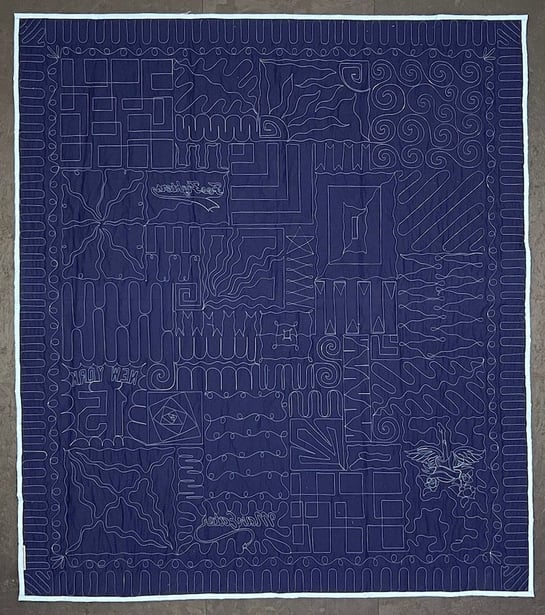 The stitching does not go over the seams from T-shirt block to T-shirt block. Each block has it's own pattern.
The stitching does not go over the seams from T-shirt block to T-shirt block. Each block has it's own pattern.- The back of the quilt is a solid color material so that the stitching can be seen.
- Some of the designs have been traced.
- The quilt maker shows off the quilting on their website.
How to Find a T-shirt Quilt Maker Who Excels in the Quilting Style You Like
 Do a Google image search for “T-shirt Quilts.” Sort through the photos and look at quilts styles you like. Read more about different quilt styles here.
Do a Google image search for “T-shirt Quilts.” Sort through the photos and look at quilts styles you like. Read more about different quilt styles here.
Once you know what style you like, click on photos you like. Go to the quilter’s website. Then look for photos or a photo gallery. Then look for photos of the backs of their quilts.
You should see photos of the backs of their quilts. If not, and if you love their style, email and ask for photos of the backs of their quilts. Ask what type of quilting they is doing.
Then compare a number of companies to find the company for you. Here is a resource that has a number of articles to help you find a quilt maker that’s a great fit for you.
Be sure you know which style of quilting you want used on your T-shirt quilt. If a company does not offer what you are looking for, keep looking!
To learn more about T-shirt quilts, visit our Learning Center.
We have over 200 articles about all aspects of T-shirt quilts.
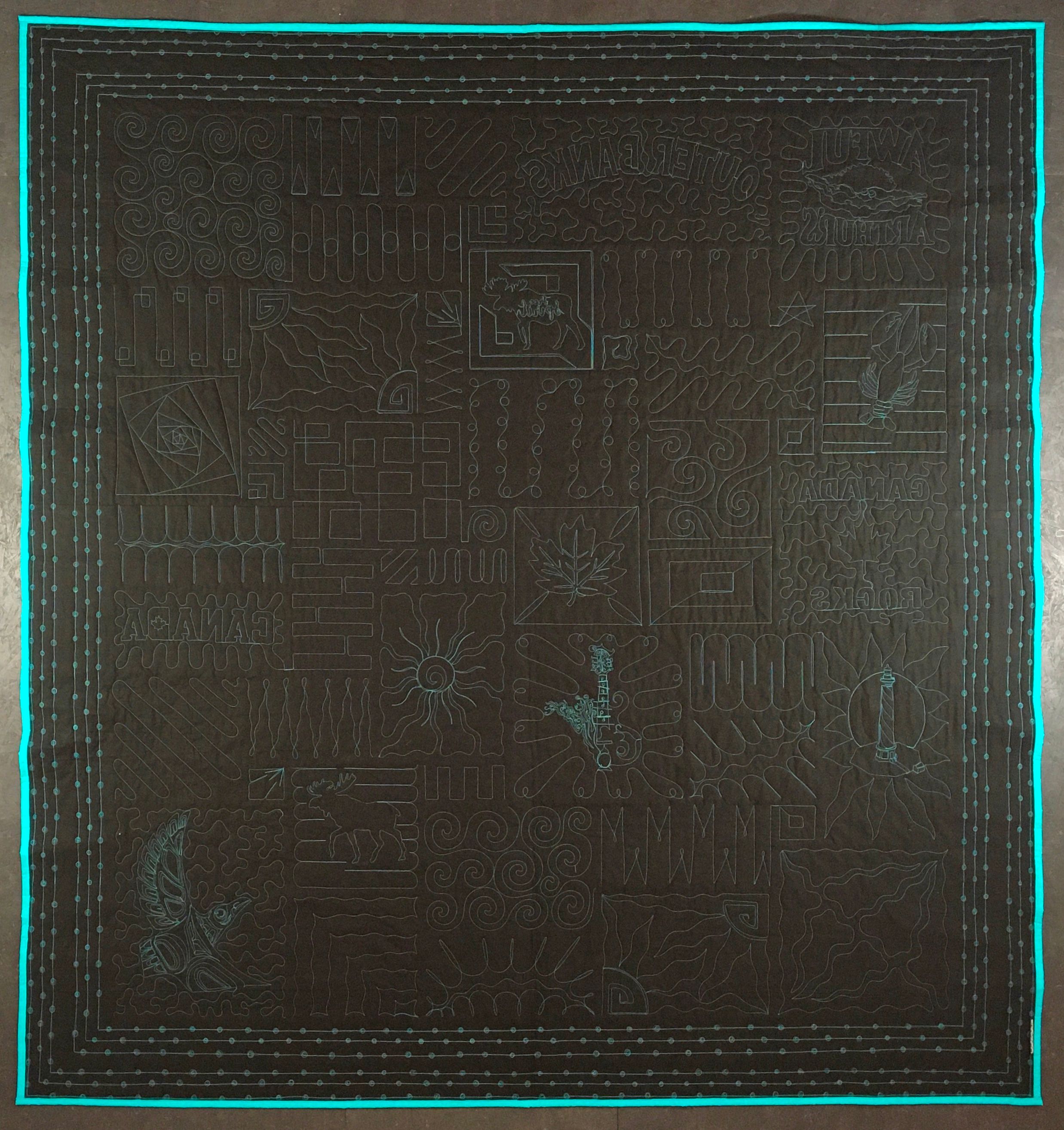
In 1992, Andrea Funk set out to reinvent the T-shirt quilt—and did. She pioneered the use of multi-size blocks and went on to develop six additional quilt styles, establishing Too Cool T-shirt Quilts as the creative engine behind the modern T-shirt quilt movement.


